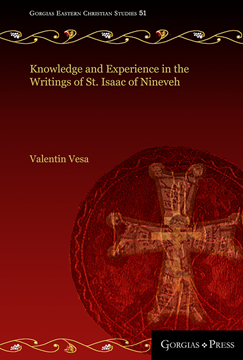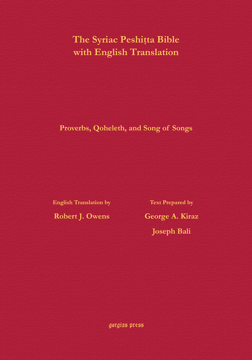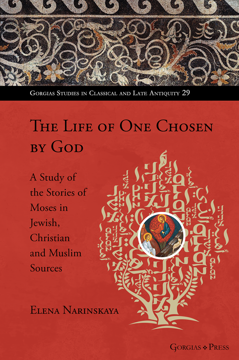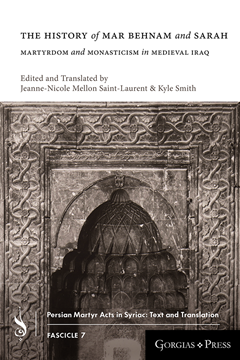Sermon on Saint Thomas, the Beloved Apostle
A Syriac Catholic Panegyric from Seventeenth Century Malabar
Translation and Introduction by Radu Mustaţă
Series: Gorgias Eastern Christian Studies 54
ISBN: 978-1-4632-3902-2
A study of a homily in praise of Saint Thomas, written in Syriac by a Catholic missionary. The homily, which is preserved in two manuscripts, is an important witness to the interaction between the Indian Syrian Christians and the Western Catholic missionaries.
$78.65 (USD) $47.19 (USD)
Knowledge and Experience in the Writings of St. Isaac of Nineveh
Series: Gorgias Eastern Christian Studies 51
ISBN: 978-1-4632-3905-3
One of the most popular monastic authors with a nearly universal spread over time is Isaac of Nineveh, a mystic of the late 7th century, who belonged to the East Syriac Church. This book is dedicated to the doctrine of knowledge, as described in Isaac of Nineveh’s discourses, in its double dimension, worldly/philosophical and theological (the former considered to be more discursive/intellectual and the latter intuitive/ experiential) and the rapport established between these two, prolonged in the concept of vision, as the highest form of spiritual experience.
$114.95 (USD) $68.97 (USD)
Hugoye - Journal of Syriac Studies (volume 20)
2017
General Editor George Anton Kiraz
Series: Hugoye: Journal of Syriac Studies 20
ISBN: 978-1-4632-3906-0
Widely regarded as a premier journal dedicated to the study of Syriac, Hugoye: Journal of Syriac Studies was established in 1998 as a venue devoted exclusively to the discipline. An organ of Beth Mardutho, the Syriac Institute, the journal appears semi-annually and will be printed in annual editions. A peer-reviewed journal, Hugoye is a respected academic source for up-to-date information about the state of Syriac studies and for discovering what is going on in the field. Contributors include some of the most respected names in the world of Syriac today.
$75.00 (USD) $45.00 (USD)
Rewriting Islamic Law
The Opinions of the 'Ulamā' Towards Codification of Personal Status Law in Egypt
Series: The Modern Muslim World 6
ISBN: 978-1-4632-3908-4
This book explores the process, effects, and results of codification of Egyptian personal status laws as seen through the eyes of the ‘ulamā’. The codification process began in the mid-1800s and continued until the abolishment of the Sharī‘a courts in 1955 with the absorption of personal status statutes into the newly drafted civil code and the national courts that administered them.
$114.95 (USD) $68.97 (USD)
Syntactic Studies in Targum Aramaic
A Text-Linguistic Reading of 1 Samuel
Series: Gorgias Biblical Studies 71
ISBN: 978-1-4632-3910-7
How can one distinguish between narrative, which records a sequence of events, and a narrator's comment on these events, in the form of notes, clarifications, and retellings? Syntax of Targumic Aramaic: A Text-Linguistic Reading of 1 Samuel applies the insights of Functional Sentence Perspective and Text Linguistics to Targum 1 Samuel. Through this analysis, Condrea answers key questions about Aramaic syntax and recovers the voice and contributions of the text's narrator.
$164.00 (USD) $98.40 (USD)
Proverbs, Qoheleth, and Song of Songs According to the Syriac Peshitta Version with English Translat
Series: Surath Kthob 18
ISBN: 978-1-4632-3911-4
This volume is part of a series of English translations of the Syriac Peshitta along with the Syriac text carried out by an international team of scholars.
$150.00 (USD) $90.00 (USD)
Jacob of Sarug’s Homilies on the Six Days of Creation (The Fourth Day)
The Fourth Day
Edited and Translated by Edward G Mathews Jr
Series: Texts from Christian Late Antiquity 52
ISBN: 978-1-4632-3912-1
In this fourth installment of the long Homily 71, On the Six Days of Creation, Jacob treats of the events of the fourth day, the creation of the spheres of light over the earth: the sun to rule over the day, and the moon and the stars to rule over the night.
$38.50 (USD) $23.10 (USD)
The Life of One Chosen by God
A Study of the Stories of Moses in Jewish, Christian and Muslim Sources
ISBN: 978-1-4632-3913-8
Moses is an inspirational prophetic figure in Jewish, Christian and Muslim religious traditions. This book journeys through the Abrahamic faiths and illustrates their respective depictions of the Moses’ stories. In exploring the differences and similarities between the Hebrew Bible, Jewish rabbinical commentaries, Syriac Christian exegesis and the Qur’an, this book seeks for a deeper understanding of the Prophet Moses in the religious history of humanity.
$155.00 (USD) $93.00 (USD)
The History of Mar Behnam and Sarah
Martyrdom and Monasticism in Medieval Iraq
Edited and Translated by Jeanne-Nicole Mellon Saint-Laurent & Kyle Smith
ISBN: 978-1-4632-3914-5
The History of Mar Behnam and Sarah tells the story of two siblings who convert to Christianity under the tutelage of Mar Mattai, a monastic leader and wonderworker from the Roman Empire. In this volume, Jeanne-Nicole Mellon Saint-Laurent and Kyle Smith provide the first critical edition and English translation of this fascinating martyrdom narrative.
$69.00 (USD) $41.40 (USD)
Aqueducts and Urbanism in Post-Roman Hispania
ISBN: 978-1-4632-3915-2
Our current knowledge of Roman aqueducts across the Empire is patchy and uneven. Even if the development of “aqueduct studies” (where engineering, archaeology, architecture, hydraulics, and other disciplines converge) in recent years has improved this situation, one of the aspects which has been generally left aside is the chronology of their late antique phases and of their abandonment. In the Iberian peninsula, there is to date, no general overview of the Roman aqueducts, and all the available information is distributed across various publications, which as expected, hardly mention the late phases. This publication tackles this issue by analysing and reassessing the available evidence for the late phases of the Hispanic aqueducts by looking at a wide range of sources of information, many times derived from the recent interest shown by archaeologists and researchers on late antique urbanism.
$114.95 (USD) $68.97 (USD)









